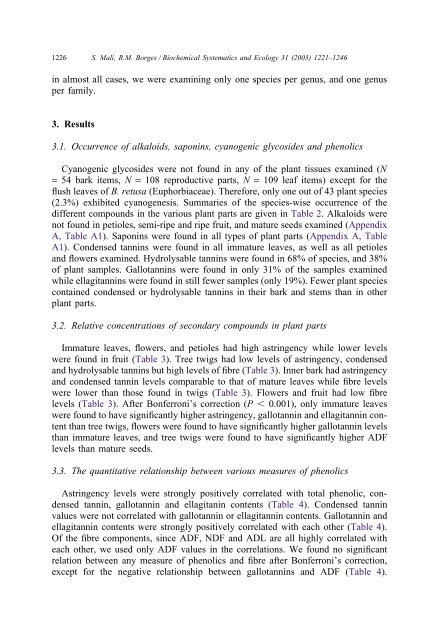Phenolics, alkaloids, saponins and cyanogenic glycosides.pdf
Phenolics, alkaloids, saponins and cyanogenic glycosides.pdf
Phenolics, alkaloids, saponins and cyanogenic glycosides.pdf
You also want an ePaper? Increase the reach of your titles
YUMPU automatically turns print PDFs into web optimized ePapers that Google loves.
1226 S. Mali, R.M. Borges / Biochemical Systematics <strong>and</strong> Ecology 31 (2003) 1221–1246in almost all cases, we were examining only one species per genus, <strong>and</strong> one genusper family.3. Results3.1. Occurrence of <strong>alkaloids</strong>, <strong>saponins</strong>, <strong>cyanogenic</strong> <strong>glycosides</strong> <strong>and</strong> phenolicsCyanogenic <strong>glycosides</strong> were not found in any of the plant tissues examined (N= 54 bark items, N = 108 reproductive parts, N = 109 leaf items) except for theflush leaves of B. retusa (Euphorbiaceae). Therefore, only one out of 43 plant species(2.3%) exhibited cyanogenesis. Summaries of the species-wise occurrence of thedifferent compounds in the various plant parts are given in Table 2. Alkaloids werenot found in petioles, semi-ripe <strong>and</strong> ripe fruit, <strong>and</strong> mature seeds examined (AppendixA, Table A1). Saponins were found in all types of plant parts (Appendix A, TableA1). Condensed tannins were found in all immature leaves, as well as all petioles<strong>and</strong> flowers examined. Hydrolysable tannins were found in 68% of species, <strong>and</strong> 38%of plant samples. Gallotannins were found in only 31% of the samples examinedwhile ellagitannins were found in still fewer samples (only 19%). Fewer plant speciescontained condensed or hydrolysable tannins in their bark <strong>and</strong> stems than in otherplant parts.3.2. Relative concentrations of secondary compounds in plant partsImmature leaves, flowers, <strong>and</strong> petioles had high astringency while lower levelswere found in fruit (Table 3). Tree twigs had low levels of astringency, condensed<strong>and</strong> hydrolysable tannins but high levels of fibre (Table 3). Inner bark had astringency<strong>and</strong> condensed tannin levels comparable to that of mature leaves while fibre levelswere lower than those found in twigs (Table 3). Flowers <strong>and</strong> fruit had low fibrelevels (Table 3). After Bonferroni’s correction (P 0.001), only immature leaveswere found to have significantly higher astringency, gallotannin <strong>and</strong> ellagitannin contentthan tree twigs, flowers were found to have significantly higher gallotannin levelsthan immature leaves, <strong>and</strong> tree twigs were found to have significantly higher ADFlevels than mature seeds.3.3. The quantitative relationship between various measures of phenolicsAstringency levels were strongly positively correlated with total phenolic, condensedtannin, gallotannin <strong>and</strong> ellagitanin contents (Table 4). Condensed tanninvalues were not correlated with gallotannin or ellagitannin contents. Gallotannin <strong>and</strong>ellagitannin contents were strongly positively correlated with each other (Table 4).Of the fibre components, since ADF, NDF <strong>and</strong> ADL are all highly correlated witheach other, we used only ADF values in the correlations. We found no significantrelation between any measure of phenolics <strong>and</strong> fibre after Bonferroni’s correction,except for the negative relationship between gallotannins <strong>and</strong> ADF (Table 4).
















